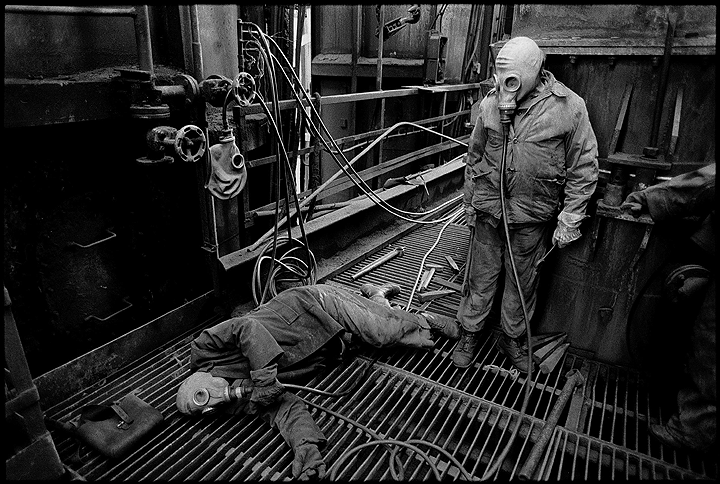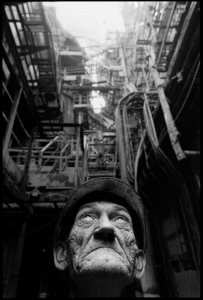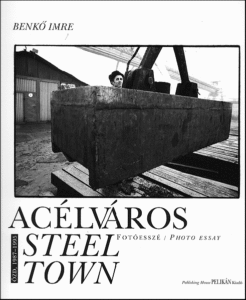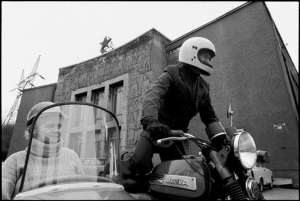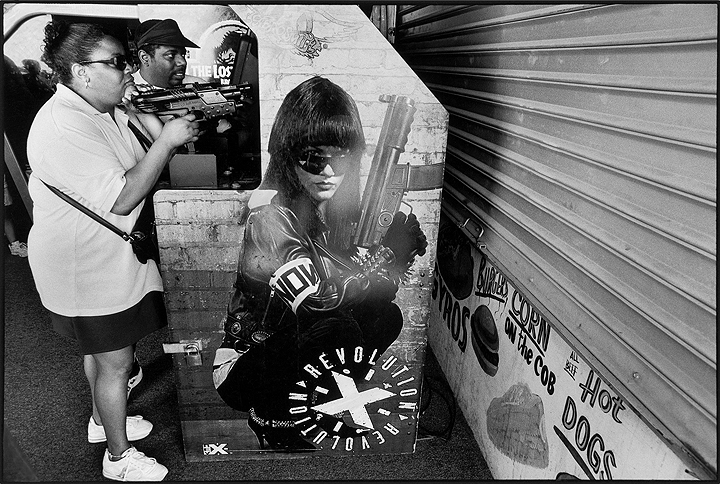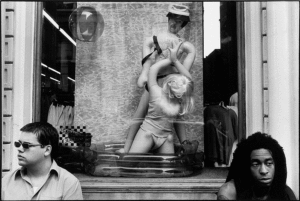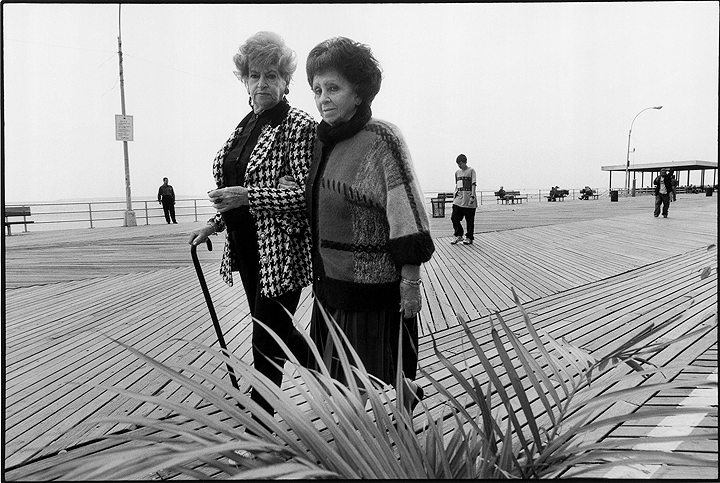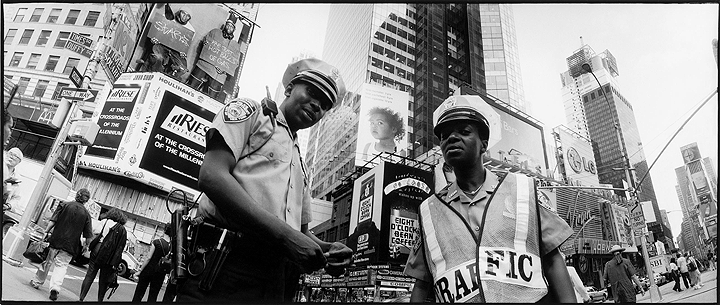Return to series table of content/ Return to VJIC Table of Content
Editor’s Note: All images reside at Fotografus (http://www.fotografus.hu/).
This installment includes two essays: The Marginal Cost of Labor and Islands.
Sándor Szilágyi, PhD, is a Hungarian media theorist, writer on photography, living in Budapest, Hungary. His interest range from Hungarian art photography, documentarist photography, and the theoretical questions of photography.
Essays © Sándor Szilágyi
First Essay: The Marginal Cost of Labor
Ózd is a steel town of fifty thousand inhabitants near the Slovakian border in Northeastern Hungary. Once a living monument to the “Heroes of Work”, it now resembles a tombstone of our Communist past. The steelworks, which in their heyday employed thirteen thousand men, have closed, leaving one-third of Ózd’s work force unemployed.
Economists and politicians argue that the closure was an inevitable result of the transition from Communism to democracy, from a planned economy to a free market. This may be true. Heavy industry in Hungary, under Communism, was supported artificially by the government, for both political and ideological reasons: the state was determined to prop up the defence sector during the cold war and to uphold the dogma of full employment. Most of the profits from agriculture and trade were pumped into industry, making its outdated technologies appear profitable. In short, the socio-economic situation of the past was largely based on a big lie–and not just in Ózd.
But the transition to democracy, and the change from a single-party to a multi-party system also heralded the era of the multi-lie. At first, Ózd’s workers were told that they would not lose their jobs and then, that only parts of the steelworks would be closed. Shortly after that, they were told that privatisation would bring new job opportunities and training in modern technology.
But for Ózd’s men and women, as well as for millions of Hungarians and other central-eastern Europeans, democracy proved costlier than they might have imagined. The vast majority lost everything they used to live and work for: financial security, a decent standard of living, a safe old age, a better life for their children. Imre Benkő’s photographs of Ózd chronicle these losses.
When Steel Town was published in 1996 it caused a sensation in Hungary’s photographic community. This was, after all, the first published book by one of the country’s most prestigious photographers, who had World Press and Pulitzer prizes behind him. Benkő, who was fifty-three, had taken the pictures over a period of almost ten years. This was part of the sensation, for in Hungary there are only a handful of photographers who work that hard on a single theme. The rest simply can not afford it. At best, newspapers and magazines pay the equivalent of the price of five rolls of film for an image. Moreover, magazines are not interested in publishing photographic reports, preferring to use photographs as illustrations. Without the help of the W. Eugene Smith Foundation, Benkő would not have been able to complete this work.
Steel Town (1996) was also well regarded for its originality and use of visual symbolism. The pictures reveal an unmistakable sympathy, even empathy, with people that transcends solidarity. Benkő was no stranger to hard labor, having grown up in a small miners’ community in the Bakony hills. As a result, he was able to take the photographs from an „insider” perspective. He is quiet and self-effacing; and his integrity may have helped the relationship with his subjects, allowing him to tell their story as it happens. He relates their tales with a tinge of irony and humor, while never indulging in melodrama, sentimental kitsch, or socio-critical clichés. This humour is deeply rooted in the traditions of central-eastern European literature and film – just think of Bohumil Hrabal and Milos Forman.
Furthermore, the amalgam of sympathy, empathy, and irony is apparent in the way Benkődepicts the backdrop to the unfolding drama. The gargantuan steelworks are pictured in dynamic lines and forms, with scenes reminiscent of a lunatic nineteenth-century version of a space station – surreal, absurd, inhuman. Just as life in central-eastern Europe was, and still is: incongruous in the space age. And Benkő chooses to show the natural geometric shapes – triangles, rectangles, circles, ellipses – as incomplete with tiny segments appearing cropped. It almost hurts the eye to see a frame cut off the top of a head, a shoe halved, the upper section of a chimney or tympanum cropped. Yet Benkő prints the whole frames of his negatives, he has a 100 percent viewfinder and often uses wide-angle lenses. If he had just taken a step back, he could have easily corrected the ‘imperfections’. These cropped compositions – whether intentional or not – are part of his visual syntax. They are tight, airless pictures.
There is no air, and the sky is empty. The quality of light that Benkő prefers is soft, and the rendering is grey. There are no deep, rich blacks or luminous whites. The drama takes place day by day, as the hopeless weekdays follow each other. And the greyest grey is the sky itself: devoid of clouds and sunshine. It is as if we looked into God’s eyes and discovered that he had gone blind.
(Reprinted from: Reportage, Issue 5, Spring 1999)
Top
Second Essay: Islands
(Delivered on 12 April 2001 at the exhibition in the Nyitott Műhely [Open Workshop] Gallery)
In this exhibition, Imre Benkő recalls two distinct schools of documentary photography. But more importantly, he also manages to revitalise the form of expression of both schools. One school, Street Photography, emerged in America after the Second World War. The movement, which embraces Andreas Feininger’s and Robert Frank’s streetscapes and William Klein’s street kids playing with a gun, brought classic American documentary practices nearer to a European form of expression. In America, documentary photography – like the press and fashion photo – expressed itself for a long time through Straight Photography, which was propagated by photographers like Edward Weston, Paul Strand, Ansel Adams, and others in the twenties and thirties.
This form of expression was characterised by: a carefully levelled large camera on a stand, correcting perspective, a large format negative (usually 8” x 10”), technically perfect prints, and arranged scenes. From these technical qualities, or camera syntax, it followed that this style exuded some kind of noble finality, increasing the authenticity and “objectivity” of the photographic establishment of facts on one hand, while on the other it was quite rigid and limited. Above all, disciples of Street Photography wanted to go beyond this: they strove to express personal visual statements in a similar photographic language to that of European photography.
In Europe, photography as art had taken a different route from that in America. Under the influence of Rodchenko, Moholy-Nagy, El Lissitzky, and other avant-garde artists using photography for their graphic works (i.e. book illustrations, posters), as well as the cinematic art that was being born in Europe around this time, another type of dynamic and exciting style developed in both documentary and press photography. The camera syntax for this, however, was completely different. A small, hand-held camera was used, and artists made use of the “distortions” of the wide-angle lens for portraying people as well. Additionally, they boldly used unusual viewpoints like the worm’s-eye view, a steep perspective shot from below, and the bird’s-eye view, an almost vertical view from above, as well as the tilted horizon. In Hungary, the work of artists Károly Escher and Judit Kárász exemplifies this documentary school.
Imre Benkő is directly linked to these schools, and yet he also creatively moves beyond them. Here, I am not just referring to his panoramic shots, but also his “traditional” shots in which he enlarges a whole Leica-format frame. These works reflect the exciting distortions of an ultra wide-angle lens with a focal length of 20 mm, as well as of those of the tilted horizon. And within this body of work there is rarely a shot that is not taken from below or above.
Benkő’s humour
Aside from these signs of form, some of Benkő’s images also illustrate one of his subtlest creative devices: an ironic, but never hurtful, mild sense of humor. The main pictorial source of this is the contrapuntal structure, or the chance meeting of dream and reality on Benkő’s visual dissecting table.
For example, the majority of the shots taken in the Hasid Jewish quarter of Brooklyn come to life in this way. Especially to a Hungarian eye, there is something bizarre in how these people walk up and down in the immediate vicinity of the skyscrapers, their clothes evoking the Middle Ages or at least the Age of Enlightenment. The photos depicting main characters alongside their papier mâché dream figures are in the same vein: the “Big Black Queen” in the virtual shooting gallery and besides her the figure of the “Goddess of Revolution”; and the cassette seller with his artistically tattooed biceps in front of a Schwarzenegger poster shot in Hungary. This same duality can also be found in a print of a Manhattan sex shop window displaying an inflatable, pouting, hairy-chested, life-sized male doll designed for use by men, and his female counterpart for use in any position. In front of it there are the emblematic figures of two men with different skin colors and bored faces, not showing the slightest interest in each other or the shop window. There is a trace of this mild, ironic humor in his other images, too, although less directly – which is a pretty rare gift in photography.
Normal and peripheral vision
Returning to the image-making devices, I believe the boldest innovation of form is best shown in the panoramic shots. Once again, it is about one of the rules of camera syntax, or rather creatively violating this rule. The usual format of a photograph is a rectangle whose sides do not exceed the ratio of 1 to 1.5, as this adapts best to the human eye’s 40-45° normal visual angle. We know that the fixed viewpoint of the camera lens and the way the living human eye sees (by wandering, resting only momentarily, flitting from here to there, and by connecting to the brain) are entirely different from each other, so that in principle it is impossible to photographically produce the image our eyes can see. Well, in spite of that – or perhaps exactly for that reason – how to make the image in a print approach what the human eye sees, and in our case how to achieve an effect with panoramic format that corresponds with the 140-150° angle of view of our peripheral vision, has always excited photographers. However, it can not be done, not because of the fixed “view” of the lens and the nature of the living, wandering eye, which varies the borders of sharp and peripheral vision from moment to moment, but because in panoramic shots it is more clearly demonstrated that we also look at photographs in a wandering way.
The camera Benkő uses is a Russian-made Horizont camera with a rotating lens system and a frame ratio of 1 to 2.5, that is a 24 x 60 mm frame instead of the usual 24 x 36 mm Leica format (Benkő always enlarges even these in their entirety). The lens with an otherwise normal angle of view rotates to take in about 150° from left to right from the photographer’s viewpoint with the aid of a clockwork mechanism (and believe it or not, a similar gadget was developed in the earliest days of photography in the mid-1840s). The special feature of shots made in this way is that the edges of the picture are not “elongated” as with a fixed, non-rotary ultra-wide angle 120-140° lens – it does not give it steep perspective. But due to the rotation, it “bows” planes parallel with the plane of the film (for instance, a wall or a fence appears larger in the centre tapering towards the edges). This is because what is exactly in the central lines is the nearest to the lens compared to the plane of the film, and the rest the lens sees increasingly further away. So much for the photograph mechanically charting reality…
Benkő exploits precisely this “distorting” effect of the rotating panoramic shot in a creative way. We gain very beautiful, exciting, dynamic views through the combination of this panoramic effect with the forms of expression of the European documentary and photojournalistic tradition—i.e. the tilted horizon, and the pictorial effects and leaning achieved by shooting from below. And the icing on the cake is turning the camera ninety degrees, which creates a portrait format panoramic image, such as the shot taken in Central Park.
Benkő has photographed the events at the Diáksziget (Student Island) on the old shipyard island in the Danube in Budapest since the inception of the music festival in 1993. He has used one-hundred and fifty reels of film, resulting in over five thousand shots to choose from for the exhibition. And, additionally, as an ironic counterpoint, the shots from the thirty reels taken in New York in May 1999 are displayed. I think they complement each other perfectly. I hope you will warmly receive these images, Imre Benkő’s modernly expressed visual sentences and personal confessions about longing (but sobering) reality.
(Beszélő, November 2001)

